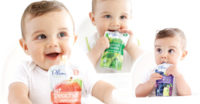Standup Pouches Add Zest to Salad Dressing Aisle
New format from Kraft-Heinz Company brings innovation to serve evolving consumers tastes.

Kraft Standup Pouches

Kraft Standup Pouches


The salad dressing aisle has remained relatively unchanged for the past few decades. Sure, new flavors of salad dressing have been added to staples like Ranch and Italian, but the packaging has remained the same. All the while, other center-store aisles have been meeting the demands of evolving consumers by transforming their on-shelf presentation with new packaging formats and product options.
There aren’t many differences in functionality or appearance from brand to brand outside of package design and branding, either. Okay, some brands have transformed from glass bottles to rigid plastic packaging or offered up contoured bottle shapes, and some have made minor changes to labeling and color schemes. Other companies haven’t made any changes at all despite the knowledge that container size, shape and appearance is critical to brand success at shelf. For whatever the reason, the salad dressing aisle remained the same while the world moved on.
That is until Kraft-Heinz Company (Kraft-Heinz) recognized that it was time to address the changing needs of customers.
On-the-go lifestyles and lunchtime salad occasions are the new norm for many consumers, making portability and convenience critical. Millennials, the most ethnically diverse generation ever, want a wider variety of packaging choices that match their tastes. The unchanging salad dressing aisle wasn’t meeting those demands. Understanding this and other insights from its consumer research, Kraft-Heinz set out to develop a solution and brought five flavors of its KRAFT Dressings to market in standup pouches.
Flexiblity for Customers
Kraft-Heinz considered a number of different types of packaging formats and solutions, one of them being the chosen flexible standup pouch. Standup pouches deliver convenience and portability: It’s easier to pack and transport a flexible, lightweight pouch over a full-size rigid container, and a pouch fits well in lunchboxes, purses, and bags or coolers for a cookout or tailgate. Offering a smaller 3.2-oz pouch, enough for two or more salads, also lowers the price point for consumers—making it easier and cheaper for them to try a few before investing in a large bottle. The overall result is Kraft-Heinz’s ability to offer a wide variety of flavors in a very convenient format at a lower risk of wasted product for the customer.
Pouches are well-established for many products globally but comparatively lag in North America. However, a recent spurt of activity by CPGs is making pouches one of the fastest-growing packaging formats, just as millennials are transitioning into the largest target segment in all of retail.
Most millennials grew up with juice from pouches, but the pouch format for products in other categories is a recent development. A lot of consumers think “kid food” when they see a product in a pouch with a cap and fitment thanks to applesauce and baby food being among the first adopters of the squeezable format. However, brands can overcome this perception with the right design.
Standout Structure for the Shelf
“We needed to rely on pouch shape, dispensing format and graphic design to ensure consumers would not associate this new salad dressing format with baby food or other ‘kid food,’” says Eric Hermes, associate principal engineer for packaging development at Kraft-Heinz. “We created the pouch in an hourglass shape that resembles our current bottle and utilized vivid salad imagery in the graphic design. This helps the consumer understand this is salad dressing and not another product. It also spoke to convenient use, is attractive for on the go, yet table-worthy at home and sized for easy trial without excessive waste.”
Beyond consumer acceptance, creating a package that met retailer requirements also required consideration and planning. The standup pouch needed to be delivered in a retail-ready secondary package, which would influence the number of pouches in each case and how many pouches could fit on a shelf. Kraft-Heinz took this opportunity to package the dressing in a way where it would be presented neatly on shelf and would remain front-facing.
Early Support and Prototyping
Introducing a new packaging format to an untried category is challenging enough, but combining that with a tight timeline to design, select, manufacture and bring the product to shelf significantly increases the risk of failure.
Kraft-Heinz recognized that significant involvement and support from its external suppliers was needed to execute and deliver to shelf within its timeline. The brand brought all key internal stakeholders and external entities—including designers and packaging suppliers at multiple levels within the manufacturing supply chain—together at the outset of the entire project.
A collaboration session was hosted by its supplier, Bemis Company, at the Bemis Innovation Center in Neenah, Wis. At the session, the team utilized the research to develop packaging concepts, created quick physical prototype options and refined the prototypes. Kraft-Heinz was assured during this time that the solutions were within manufacturing feasibility parameters and could be executed according to the project timetable. During each step, the needs of the consumer—convenience, portability and variety without waste—were at the forefront of the discussion. The challenges of differentiating the package from “kid food” and being able to have a strong on-shelf presence dominated decisions as well.
In just 48 hours, Kraft-Heinz walked away with executable prototypes for immediate evaluation. The sessions at the Bemis Innovation Center proved to be the critical step to ensure a successful product launch within project timing and risk parameters. Typical projects that involve a packaging change usually consist of months and months of back and forth emails, conference calls, revisions and questions. However, this two-day rapid prototyping collaboration eliminated all wasteful steps.
“The advantage of having everyone in the room at the same time allowed us to quickly understand and frame up what successful execution looked like from a material, style, graphics and operational standpoint,” Hermes explains. “As issues came up, we were able to arrive at solutions quickly because of stakeholders and partners collectively providing watch-outs and must-haves. This saved us time and money since we eliminated the risk of having to go back and do rework.”
Testing to Mitigate Risks
Being the first to make a change in a category carries risk. Once all of the packaging elements came together, the key question was whether the product would deliver the desired shelf impact. Would consumers notice it, or would it disappear in a sea of dressings?
To get the answer, Kraft-Heinz conducted on-shelf findability and purchase intent research to understand the impact of package graphics and format. The pouch surpassed its expectations, and the research gave Kraft-Heinz confidence that the package format would not go unnoticed. “Our research indicated that the pouch concept performed very well in terms of acceptance to millennials and the general population for salad dressing,” says Hermes.
Kraft-Heinz’s product and packaging innovation meets the needs of its evolving consumer. Because of that, it will be a welcome addition to the salad dressing shelf space and give that section the update it has sorely needed.
Looking for a reprint of this article?
From high-res PDFs to custom plaques, order your copy today!









